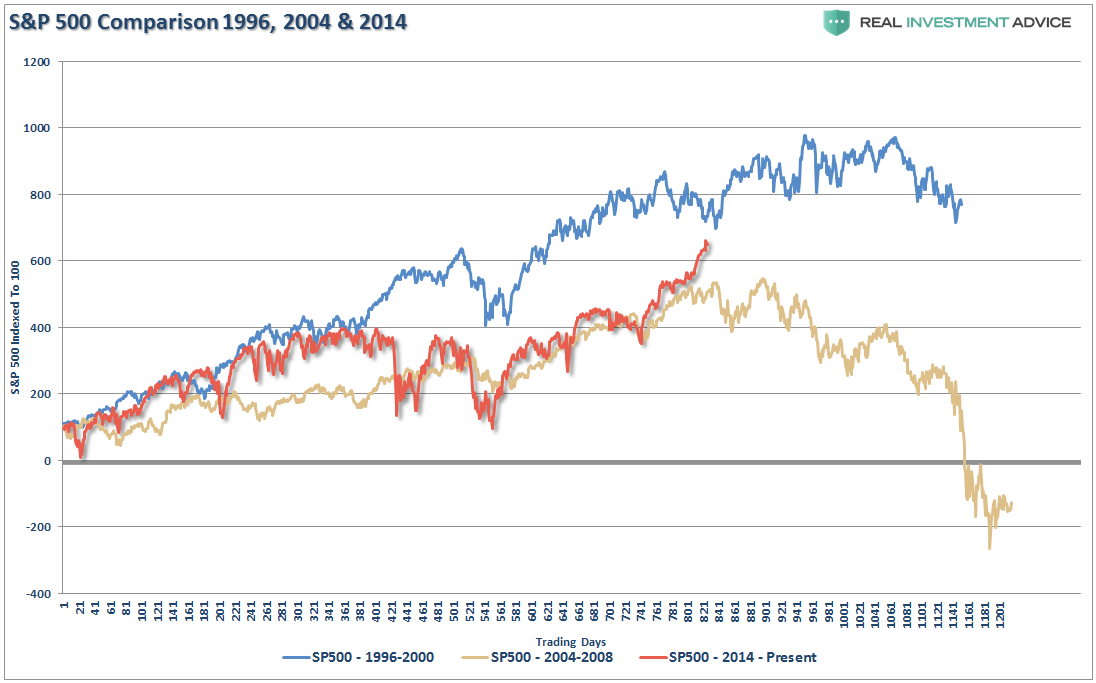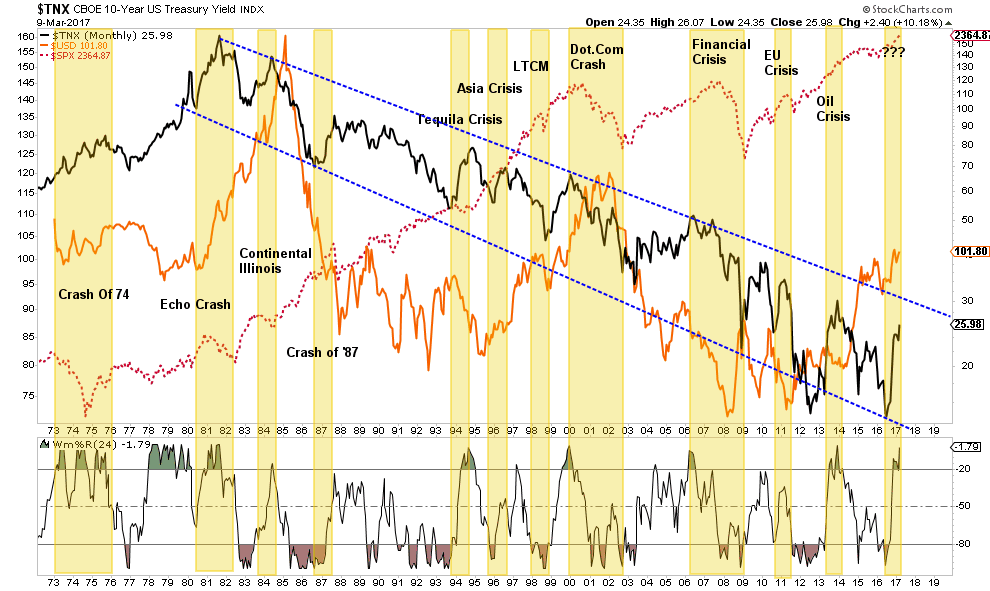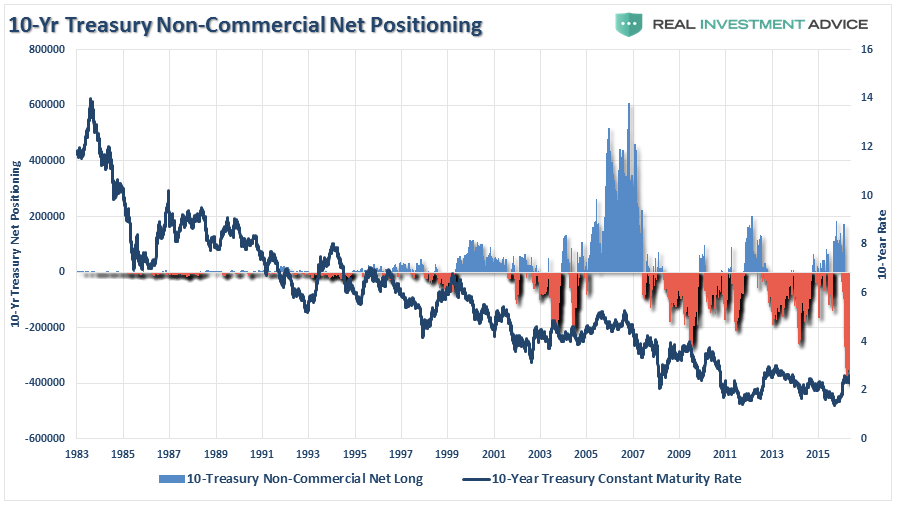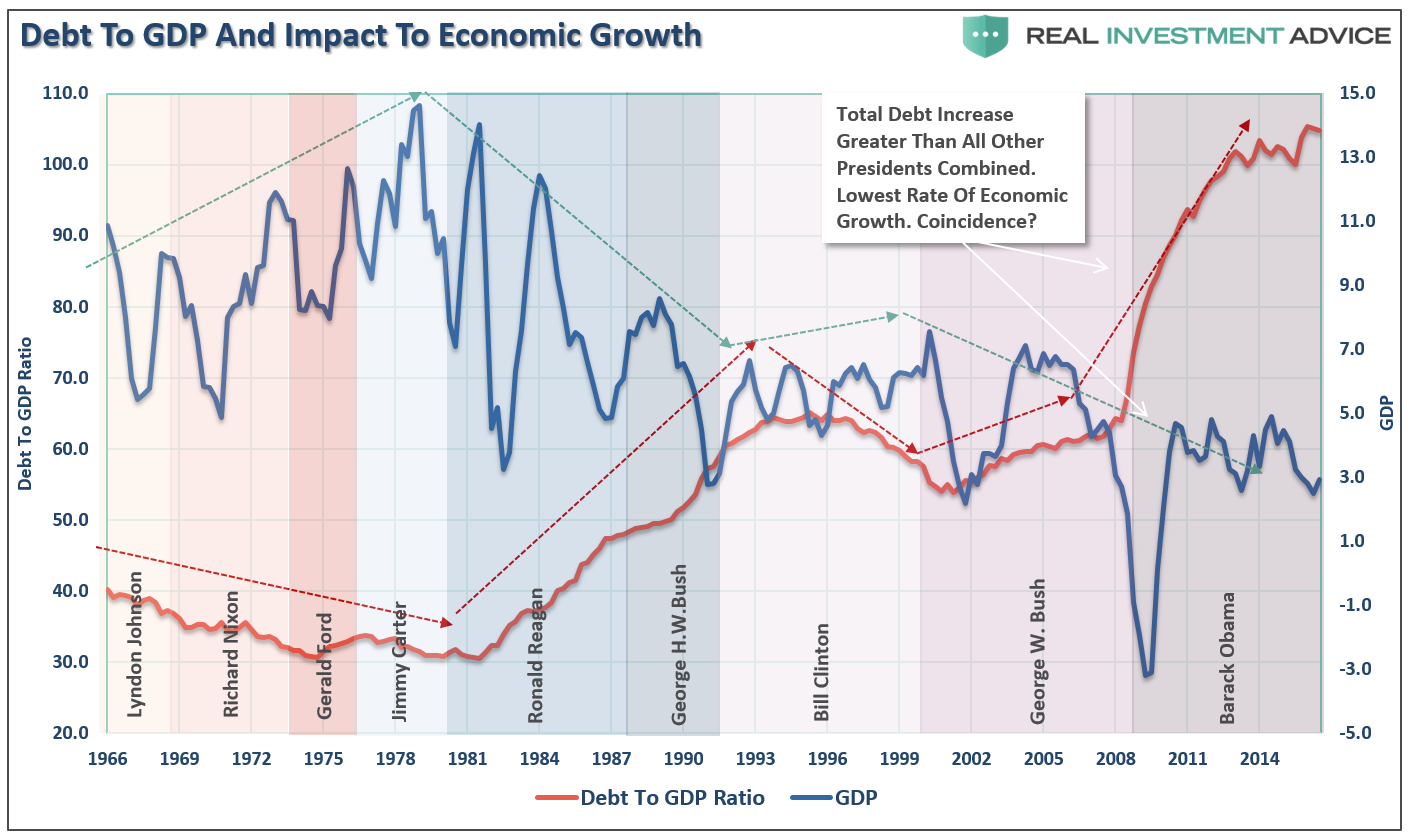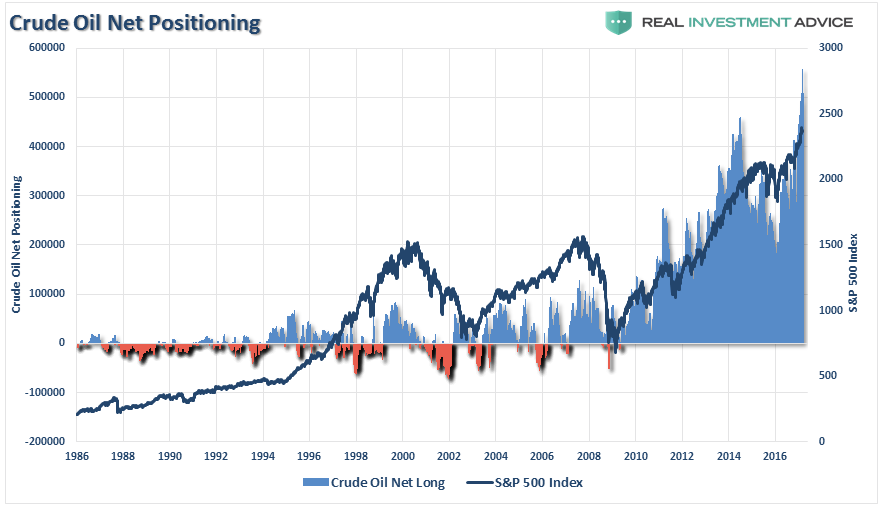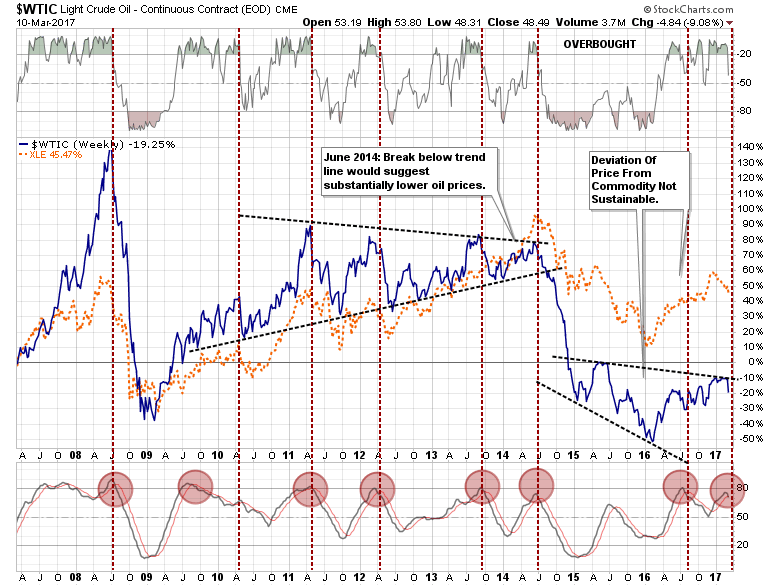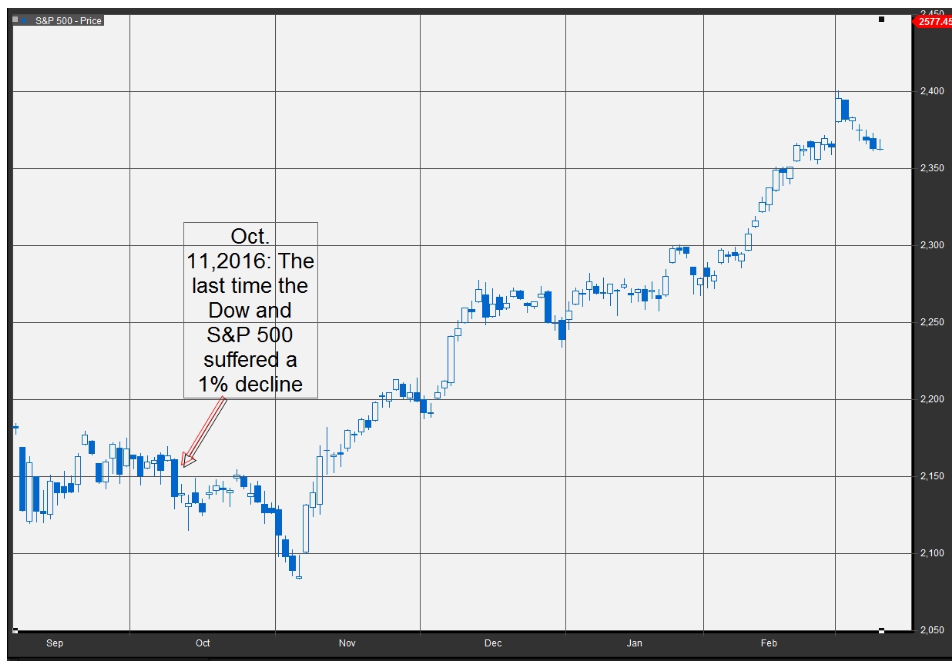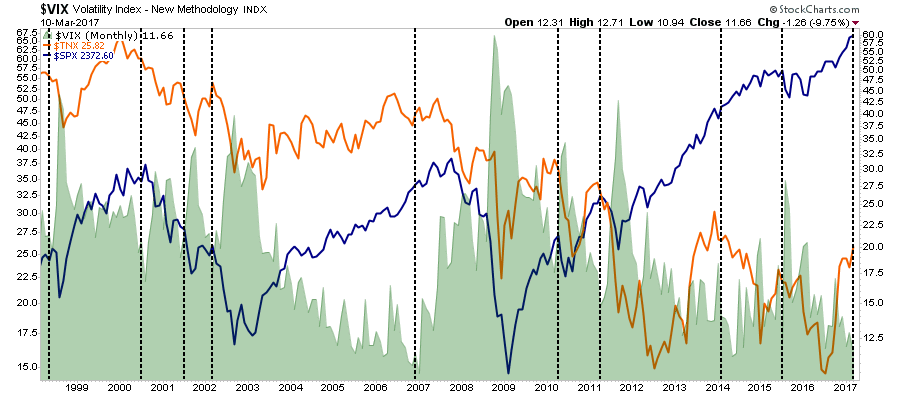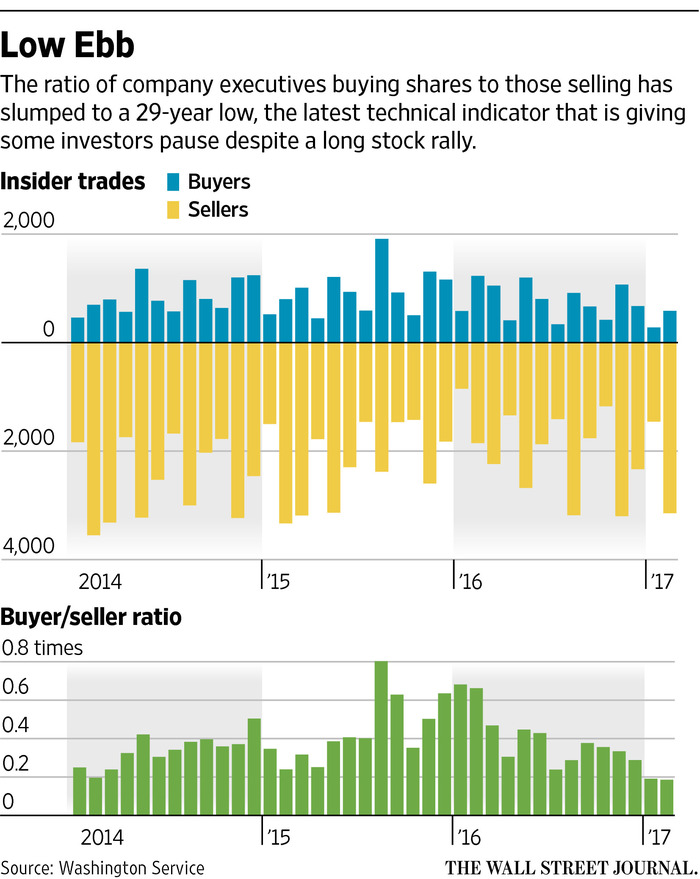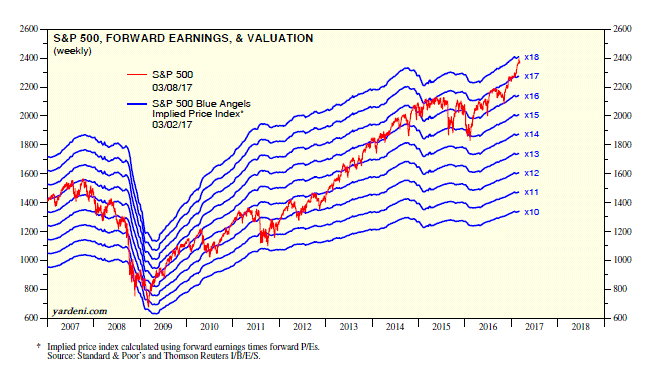

| Online: | |
| Visits: | |
| Stories: |

| Story Views | |
| Now: | |
| Last Hour: | |
| Last 24 Hours: | |
| Total: | |
The Very Strange State of the Market
Authored by Lance Roberts via RealInvestmentAdvice.com,
Last week I reviewed Why This Market Reminds Me Of 1999:
“While there is much hope the new President, and his newly minted cabinet, will “Make America Great Again,” there can be a huge difference between expectations and reality. And, like in 1999, there is just the simple realization that eventually excesses will mean revert.
But like I said, with only a 6-month holding periods, fundamentals ‘need not apply.’
So, while I don’t like chart price comparisons in general, if you take the sum of the economic and fundamental data above and compare it to previously ‘overly exuberant’ periods, you see this:”
Note: S&P 500 has been indexed to 100 to compare price movement during the 1200 trading days measured.
This past week, several areas of the market began to unravel.
First, the bond market was hit hard as expectations of a Fed rate hike next week sent money scurrying out of bonds.
However, this recent pop in rates, when combined with a stronger dollar which drags on corporate exports (roughly 40% of earnings), has historically been an excellent opportunity to add to bond exposure. As shown below, the Federal Reserve, in their eagerness to hike rates, are once again likely walking into an “economic trap.”
Also, whatever causes the next reversal in rates will coincide with an unwinding of the still very massive speculative net short in bonds.
I agree with Albert Edwards on his discussion of rates.
“Make no mistake. Unlike most in the markets, I remain a secular bond bull and do not think this 35 year long bull bond market is over. I believe the US Fed has created another massive credit bubble that will, when it bursts, lay the global economy very low indeed. Combine this with the problems of a Chinese economy dependent on increasingly ineffective injections of credit to produce increasingly pedestrian GDP growth and you have a right global mess. The 2007/8 Global Financial Crisis will look like a soft-landing when the Fed blows this sucker sky high. The seeds for that debacle have already been sown with the Fed having presided over one of the biggest corporate credit bubbles in US history. All that is needed now is for the Fed to sprinkle life-giving rate hikes onto these, as yet dormant, seeds of destruction. Accelerated Fed rate hikes will cause tremors in the Treasury bond markets, forcing rates up, most especially in the 2 year – just like 1994. But as yet another central bank-inspired global recession unfolds, I believe US 10y bond yields will ultimately converge with Japanese and European yields well below zero – in other words, buy 10y bonds on weakness!”
Of course, it isn’t JUST the Federal Reserve hiking rates which pose a risk to the markets. There is also this little problem that suggests rates will remain low for a very long time to come.
Secondly the oil market. As I discussed a few weeks ago:
“Crude oil positioning is also highly correlated to overall movements of the S&P 500 index. With crude traders currently more ‘long’ than at any other point in history, a reversal will likely coincide with both a reversal in the S&P 500 and oil prices being pushed back towards $40/bbl. “
Of course, with oil companies rushing out to increase drilling following the recent pop in oil prices, it was only a function of time until someone woke up to the reality of the build in still bloated inventories. (Also, despite President Trump’s exuberance over the building of the XL Pipeline, the last thing oil companies need right now is another 800,000/bbl’s a day in supply.)
Importantly, despite the recent decline in oil, the massive net-long position in oil remains which suggests further downside in the weeks ahead.
This is important because the rise in oil prices has been the support for:
- A big chunk of the earnings recovery.
- Increased rig counts have fueled employment (along with the unseasonably warm winter skewing the manufacturing employment data)
- The increases in inflationary pressures have come primarily from healthcare costs, rent and increased energy costs. (Which is why the Fed’s rate hikes may cause a problem.)
As I have discussed in past missives, the detachment between oil prices and the underlying fundamentals pose a significant threat to those that piled into energy-related stocks in recent months. With everyone on the long-side of the energy trade, the reversal will likely be brutal.
(Note: The chart below contains my June 2014 call to get out of oil/energy related stocks. With the massive long position in oil prices, the long-term correction is likely not yet complete.)
Third, the spike in rates also impacted other interest rate sensitive sectors of the market which have been performing well since the beginning of the year.
REIT’s, Staples, Utilities, Preferred Stocks and, of course, Bonds were all hit hard this past week.
However, despite all of this reversions eruption of activity, the markets remained relatively unfazed with volatility remaining suppressed. As Mark DeCambre wrote on Thursday:
“Buoyancy. That is what this indefatigable equity market has come to be known for over a four month stretch that has failed to yield a decline of at least 1% for either the S&P 500 or the Dow Jones Industrial Average. That is 102 trading sessions dating back to Oct. 11.”
While it’s not a record, it is an extremely long time for volatility to remain suppressed. As shown in the chart below, such complacency does not, and has not, lasted forever. I have included the 10-year Treasury rate as spikes in the VIX, which have corresponded with declines in stocks, have also correlated to declines in interest rates as money rotates from “risk” to “safety.”
This is a very strange state in the market currently.
No matter what happens, seemingly there is little concern. But it is that lack of concern that historically turned out to be the problem.
With the debt ceiling debate, Fed rate hike and Dutch elections all coming to fruition next week, there are plenty of potential catalysts to create a pick up in volatility.
We lifted some profits out of portfolios last week which has been helpful in lowering portfolio volatility. However, depending on what happens this coming week, there may be more work that needs to be done.
Insiders Aren’t Buying It
Chris Dieterich and Ben Eisen had a very interesting piece in the WSJ hitting on a most important issue.
However, before we get into their analysis, let me remind you of something.
The whole premise of the “Trump Rally” is that lower tax rates, lower regulations, and infrastructure spending is going to juice earnings of companies and drive asset prices higher.
If that is the case then how do you explain this:
“Corporate executives are buying their own firms’ shares at the slowest pace in at least 29 years, the latest sign of uncertainty as the bull market in U.S. stocks enters its ninth year.
Share purchases and sales by executives are parsed by investors searching for signals about what insiders expect from the market. Sales can show wariness about valuations, while purchases can signal confidence that more gains lie ahead.
Insider buyers have been scant. There were a total of 279 insider buyers in January, the lowest number going back to 1988, according to the Washington Service, a provider of insider-trading data and analytics.”
“Meanwhile, the number of sellers has been above average, pushing a ratio of buyers to sellers in February to its lowest since 1988.
Insider caution about buying stocks comes with the S&P 500 near a high and after the index has more than tripled since bottoming during the financial crisis on March 9, 2009.
While many investors expect corporate earnings to pick up in coming quarters, reflecting the continuing U.S. economic recovery and Trump administration tax-cut and deregulatory plans, the strong market gains mean that investors are paying more now for expected corporate earnings than at any point in over a decade.
The price-to-earnings ratio of the S&P 500 based on analyst forecasts for the next year is near 17.7, the highest since 2004, according to FactSet.”
Of course, valuations are a key issue going forward as:
“What you pay today, has everything about what your return on investment is tomorrow.”
As Ed Yardeni recently noted:
“Putting all these trends together in our Blue Angels charts shows that the market is certainly flying high. Valuations suggest that stock prices are too high.”
So, in other words, if they aren’t buying the rally – should you be?
Just a thought.

Source:



